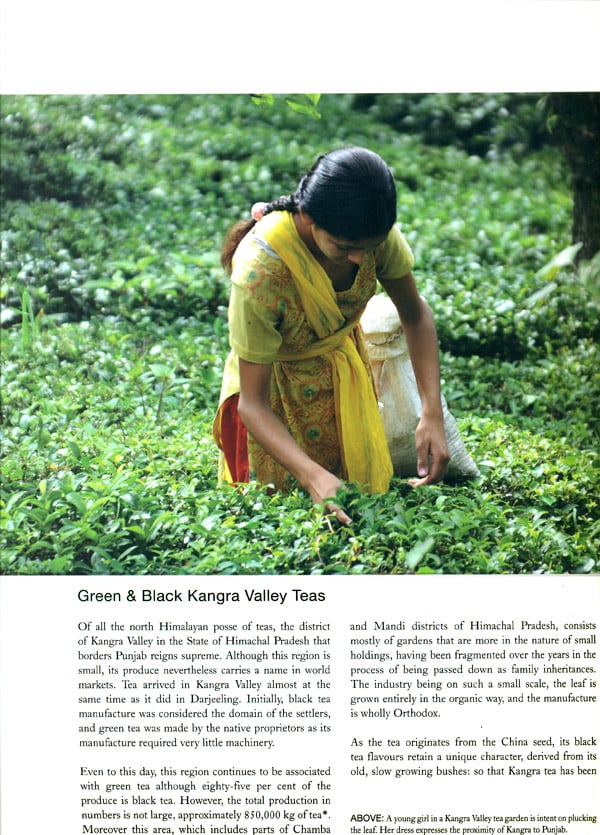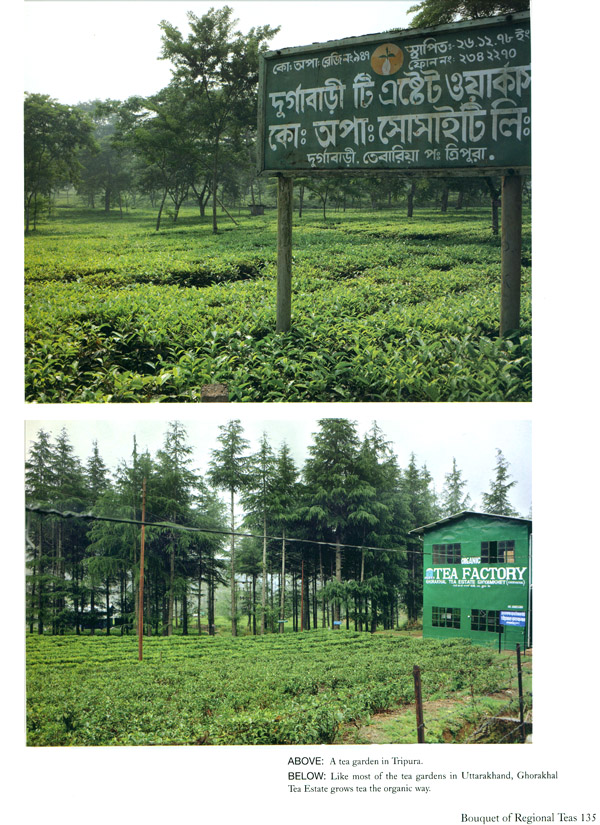
Chai :The Experience of Indian Tea
Book Specification
| Item Code: | NAJ999 |
| Author: | Rekha Sarin |
| Publisher: | Niyogi Books |
| Language: | English |
| Edition: | 2014 |
| ISBN: | 9789381523919 |
| Pages: | 302 (Throughout Color Illustrations) |
| Cover: | Hardcover |
| Other Details | 13 inch x 10 inch |
| Weight | 2.20 kg |
Book Description
About the Book
Chai: The Experience of Indian Tea is a pictorial journey through time, into the heartlands of tea, across the length and breadth of the vast and diverse nation that is India, offering the reader a varied selection of the universally popular brew.
It affords a glimps into the making of the cup that cheers the locales, the people ant the process-a visual treat for the tea connoisseur, the casual tea lover, the tea industry enthusiast or the tourist looking for off-the beat, unexplored, pristine holiday spots.
The repertoire of teas offered by India is, perhaps like none other in the world. The geographical spread and climate variations of the land impart district characteristics to the different varieties of tea grown in each region , be it Assam, Darjeeling, Nilgiris, Kangra Valley, Dooars or the like.
The book brings alive the entire panoramic picture of these ever-special Indian teas through an array of brilliant photographs and meticulously researched text that together spin and weave the tea story.
Starting from the Indian tea experience and origins of the brew in India, it transports the reader into the fascinating world of the tea gardens, the bountiful natural landscapes and regional cultural nuances.
It focuses on the labour intensive process of growing and plucking the leaf, the intricacies of production, professional tea tasting, tea auctions and e-auctions, all of which reflect hte vastness of the industry at work.
It also traces the history of the brew and its travels from china to western world and reveals the myriad perspectives that go beyond the brew, to make tea an experience to be cherished.
The book is an impassioned endeavour to draw the reader into the true magic of tea that reflects the marvel of nature, human perseverance and intelligence.
A true tea aficionado’s delight and joy for the book lover!
About the Author
Rekha Sarin, is a Delhi –base freelance writer and a contributing editor, writing for leading Indian magazines and newspapers, as well as for overseas journals, on subjects of travel culture and interior design.
A graduate from the University of Delhi, she qualified with a gold medal from the Bharatiya Vidya Bhavan School of Journalism, and is the recipient of the Times of India gold medal.
An inveterate lover of nature, she is also a professional floral decorator and her first book, on the art of flower arrangement was well acclaimed for its lucid style of presentation. This is her second book.
Preface
During the course of our journey through the world of Tea, we have become ardent admirers of the beverage. No doubt, all tea lovers are passionate about their cup of tea-our perceptions have expanded far beyond. We now behold our cup in a spirit of reverence. Tea is a legacy of mankind, a boon that has resulted in a remarkable synergy between the working of Nature and the intelligence and skill of the human mind and hand.
In this book, therefore, while presenting an insight into the exhilarating aromas and characters of the innumerable varieties of Indian teas, we also seek to highlight the extraordinarily multifarious facets of the brew that impact our daily lives in more ways than one.
Our opening section introduces Chai, as construed and experienced in India, traces the history of its advent to India and highlights the contemporary scenario of the tea industry of India.
In this, our land of social contrasts, tea-drinking culture is a skein that runs through the warp and weft of the multi-ethnic tapestry of Indian society. Moreover, tea is an epitome of Indian hospitality. Be it the handyman who comes to do a repair job at home or the most revered guest, it is offered to all. From roadside tea stalls to luxury hotel lounges, or snazzy tea bars, it is available to all. Chai, thus, makes a national statement.
By the early nineteenth century, during the era of colonialism, the British East India Company was bartering tea with China in exchange for opium being grown in India. This eventually resulted in the Opium Wars as the Chinese, realising their monopoly, began to demand a heavy price for tea in the form of silver bullion. Besotted as they were with tea, the colonists then had no choice but to explore an alternate solution. They undertook all sorts of tribulations to finally discover and realise that the jungles of the Assam Valley in north-east India were home to a very special indigenous variety of tea plant. The watershed moment for tea in this country came on February 12, 1839, when the first ever commercial tea company in the world, the Assam Company, came into being.
India thus, is one of the star players in the annals of tea history, and today it is the largest producer of black tea in the world. It also ranks as the fourth largest exporter in the world, even while accounting domestically for approximately twenty per cent of global consumption.
There is a prolific tea industry that exists in the country, with a magnitude that ranges from business houses who have a large stake with massive hectares of tea plantations that produce millions of kilograms of tea, to small growers who rely on 'bought leaf factories' for their produce; from multinational conglomerates and international brands to local players whose labels find popularity in small towns. The Indian marketplace is accommodating and receptive.
The heartlands of tea are spread over a beautiful and diverse geography that is intrinsic to this vast subcontinent. In our second section of the book, we present these regions that yield a plethora of teas that result from the physical attributes of their varying habitats, each variety being incomparable in character. Where else can you find the robust, rich and malty Assam teas with their zesty strength? Or the delightfully delicate and aromatic Darjeeling teas, produced in this picturesque east Himalayan district that is as exclusive to India as the Champagne district is to France? Or the bright, full bodied teas from the Nilgiris and the Western Ghats that come from the southern parts of the country? Then again, regions like Dooars, Terai and Kangra Valley make their own significant contribution.
Visit a tea plantation and you are in the lap of natural beauty. Besides being refreshed by the finest teas from the gardens, enjoy the pristine environment with spectacular views, gurgling rivers, trekking trails and jungle wildlife. Together with the Indian cultural rainbow of region ally diverse dialects and customs, quaint village homes and local celebrations, the tea trail across India presents a panorama that is as diverse as the cornucopia of tea characters that emerge from each of these regions.
In the third section we take a look at the transformational journey of the leaf to the sip. Its pages describe the 'flushes' or cycles of growth of the tender green shoots and their final transformation to the familiar black dried tea leaves that we use for our brew. Plucking the young leaves and the buds that go together in the making of the finished tea is an operation that is a selective toil done by the hand, so delicate that it is best performed by the female hand. It cannot be replaced by any form of new- age mechanisation. As such, not many of us realise that there is a massive labour force that plucked thousands of young shoots one-by-one, to eventually yield the finished product of tea as we know it.
Most of the large tea plantations carry forward the heritage of the past. The tea planter is not only responsible to produce a quality cup, but he is also accountable for the welfare of thousands of workers on the plantation, several of them having lived there over generations. Being remote and isolated, these vast plantations are more like self-contained townships.
The actual production of tea leaves involves intelligent evaluation, using temperature-controlled techniques that are employed during withering, rolling, fermentation and drying. The tea is either marketed directly or packed in 'lots' that are put up for tea auctions. Critical to the quality control process is the professional tea taster, who with his expertise, appraises and discriminates a good tea from an average one. He also creates the blends that make up the spectrum of commercial brands.
The final section of the book highlights the universal popularity of the beverage-beginning with tracing the history of tea from its origins in China and its emergence in Europe, it goes on to sum up the appealing aspects of the universally favoured drink. This is a drink that ha traversed the passages of time, giving rise to several significant historic events, besides enriching lands with a special culture that is an outcome of individual styles of service and manner of taking to the beverage.
Commencing with its discovery in China by the erudite Chinese emperor, Shen ung in the year 2737 BC, tea moved on to neighbouring Japan, and spread to Europe through cross-continental maritime activity, finally arriving in England by the middle of the seventeenth century. Soon enough, the drink became a rage. This section presents the several profiles of the beverage that offer the tea lover choices for every mood or occasion.
In fact, simply savour your cup of tea, just the way you like it. Feel good, as studies show that this beverage has substantial health benefits.
If you are adventurous in your tastes, this versatile drink makes a wonderful fusion with other flavours. And what's more, as featured in our chapter on recipes, the delicate flavours of tea can be used to advantage in cooking too.
Tea then is a beverage that deserves appreciation in every measure. As a tribute to this blessing of Nature, we met with several tea professionals and visited many a tea plantation across almost all the tea regions in India to present the manifold aspects of this subject and capture its charming beauty through the lens. In the process , the complexities of this fascinating drink have been a revelation to us, and we now appreciate our daily cup with renewed delight. We hope you, our readers, enjoy participating in the tea experience, page by page, sip by sip.
Contents
| Preface | 9 |
| Chai the Indian Way | 13 |
| Ever Popular Chai | 15 |
| How Tea Came to India | 35 |
| Contemporary World of Indian Tea | 51 |
| Into the Heartlands of Tea | 59 |
| Picturesque Tea Tourism | 61 |
| Bounty of Assam | 71 |
| Divine Boon of Darjeeling | 85 |
| Bonanza of South India | 105 |
| Bouquet of Regional Teas | 131 |
| From the Leaf to the Sip | 151 |
| Plucking the Leaf | 153 |
| The Planter's Life | 173 |
| From Nature to Man | 187 |
| The Tea Taster's Verdict | 205 |
| Tea the Universal Brew | 221 |
| The Saga of Tea | 223 |
| Choices for the Tea Lover | 249 |
| A Cupful of Health | 263 |
| Recipes with Tea | 271 |
| Finally the Perfect Cup of Tea | 284 |
| Author Note: | 286 |
| Rajan’s Vision/ Rekha’s Musing | 286 |
| Acknowledgements | 288 |
| Photo Credits | 291 |
| Select Bibliography | 293 |
| Glossary | 293 |
| Index | 297 |







